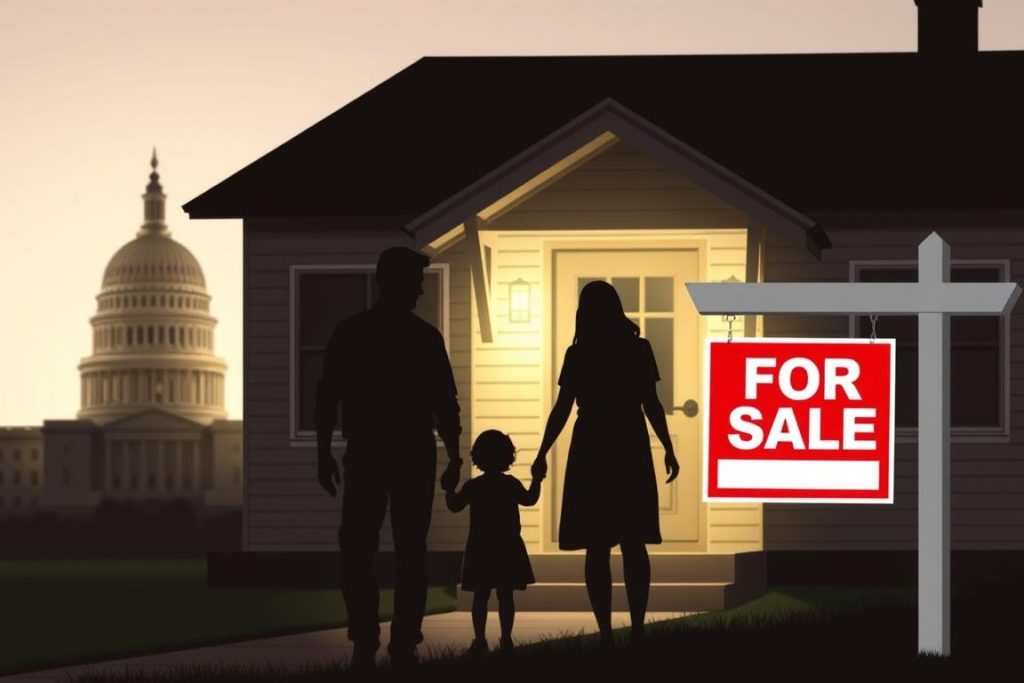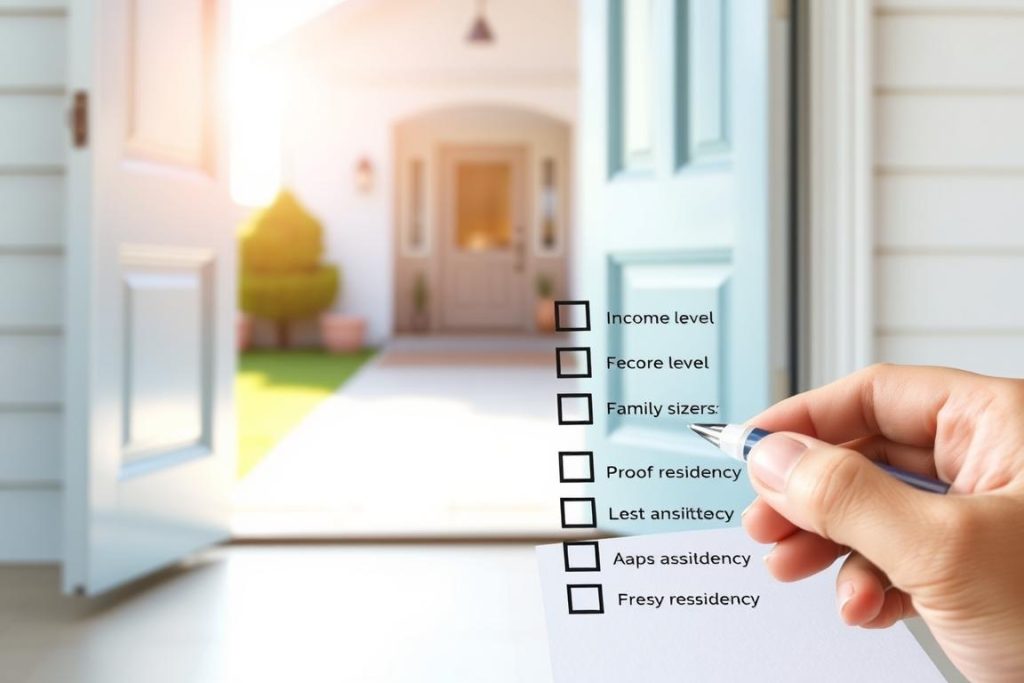Every year, the Housing Choice Voucher program helps over 5 million people in more than 2 million families. This means that finding affordable housing is more possible than ever. The government has made many programs to help people and families get the homes they need without breaking the bank.
There are many kinds of help available, like rental assistance, buying a home, getting through a housing crisis, stopping a foreclosure, and making your home better. These programs also teach you how to update your address with the government and solve problems with landlords or property managers.
But the help isn’t just about money. For veterans who don’t have a home, there is a special hotline at 1-877-424-3838. And if a veteran is in crisis, they can call 1-800-273-8255 for immediate help. A sign of success is the nearly 3 million homes created under the Low-Income Housing Tax Credit (LIHTC) program.

We’re going to look closely at how government housing assistance works in this article. We’ll show you the key programs that can make living affordably a reality for you. No matter your situation—facing foreclosure, dealing with the housing market, or needing home repairs—there’s a government program ready to help.
Key Takeaways
- The Housing Choice Voucher program supports over 5 million individuals annually.
- Nearly 3 million LIHTC units have been implemented across the nation.
- Government programs offer extensive resources beyond financial assistance, including dedicated hotlines for veterans and distressed homeowners.
- Understanding various government housing programs can help you find secure and affordable living.
- Assistance is available for rental, home buying, emergency housing, home improvements, and more.
- Diverse aid includes help with address changes, landlord disputes, and preventing foreclosure.
Government Housing Assistance Programs for Low-Income Families
Government programs help low-income families find safe and affordable homes. They offer several types of help based on a family’s needs. This helps ensure everyone can find a fitting housing option.

Public Housing Assistance
Public Housing Assistance offers affordable homes for low-income families. Local agencies manage these units, helping nearly 970,000 households in the U.S. The HUD checks if families qualify based on income and size.
HUD sets income limits to determine who qualifies. Families pay a portion of their income for rent. This amount is called Total Tenant Payment (TTP). It is based on their earnings minus some deductions.
Section 8 Assistance
The Housing Choice Voucher Program, or Section 8, helps families rent affordable homes. This program allows families to choose where they live. It also helps with part of the rent. For instance, in North Carolina, eligible families get up to 30% rent subsidies.
In 2023, about 2.4 million households benefited from Section 8 vouchers. These vouchers help in certain counties. Programs like the Mainstream Voucher and the Emergency Housing Voucher focus on special needs.
Rural Housing Subsidies
Rural Housing Subsidies support families in less populated areas. They help with rent and buying a home. Living in rural areas comes with challenges, such as fewer housing options. These subsidies aim to improve living conditions.
In 2023, $14 billion supported programs for the elderly, disabled, and rural renters. Those in need can find more information through local agencies and housing inspectors. They offer guidance on applying for assistance.
| Program | Households Served (2023) | Funding (Billions) |
|---|---|---|
| Tenant-Based Assistance | 2.4 million | $30 |
| Project-Based Assistance | 1.2 million | $15 |
| Public Housing | 790,000 | $8 |
| Rural and Other Housing Programs | Varied | $14 |
Eligibility Criteria and How to Apply for Housing Assistance
It’s important to know the eligibility criteria and how to apply for housing aid if you’re looking for an affordable home. There are many programs for those with low income, disabilities, homeless veterans, and more. These programs help with rent.

Eligibility Requirements
The rules for getting housing help depend on the program and where you live:
- Income Limits: Programs have income caps. For example, the Section 8 Voucher Program helps low-income families, the elderly, and disabled people.
- Residency Requirements: Some aids like Section 811 PRA are only in certain cities.
- Family Status: Programs look at how big your family is and other details. The Family Self-Sufficiency Program has its own five-year goals for participants.
Application Process
Getting into a housing program involves a few steps:
- First, find the right local housing authority or agency. The HUD website is a good place to start.
- Then, fill out a housing aid application. You can usually find this online or in person.
- Next, turn in documents like income proof, where you live, and how many are in your family.
- Finally, wait for them to review your application. Some places, like Austin’s Housing Authority, might have a waitlist.
Some specials, like the Down Payment Assistance Program, have extra steps. You need to go through a homebuyer course approved by HACA. Plus, you must invest at least $2,500 to get the loan help.
| Program | Eligibility Criteria | Application Process |
|---|---|---|
| Section 8 Housing Choice Voucher | Low-income individuals and families, elderly, and people with disabilities | Apply through local public housing authority, submit documentation, wait for review |
| Section 811 PRA | Extremely low-income persons with disabilities | Available in specific metropolitan areas, apply through designated agencies |
| Down Payment Assistance Program | First-time home buyers, must complete a homebuyer training course | Apply through HACA, meet minimum investment amount, attend training |
Getting to know the rules and what you need to do helps a lot. For those needing affordable homes, this could be the key. Follow each step carefully to get the housing help you need.
Types of Subsidized Housing Options Available
Exploring subsidized housing options might seem tough at first. There are public housing, Section 8 vouchers, and targeted programs for specific groups. Learning about them can make things easier.
Public housing offers government-managed homes to over 1.2 million households. It’s for low-income people, giving them a safe place to live. These homes are managed by Public Housing Agencies (PHAs). To qualify, your income must be below 80% of your area’s median.
The Section 8 Housing Choice Voucher program helps another way. It lets people rent from private owners and pay part of the rent. About 2.1 million households use this, making more housing options affordable.
There are special programs too. The Section 202 program is for very low-income seniors, 62 and up. It provides homes and supportive services. Rural housing subsidies help families in non-city areas, reaching communities that are often forgotten.
Choosing the right program takes some thought. Consider how much space you need, location, and how much you can spend each month. Local housing authorities have preferences that might affect waiting times and program availability.
Applying for these programs means gathering lots of documents. You’ll need proof of income, family size, credit history, and references. But getting through the paperwork is worth it. These programs are designed to offer safe, low-cost housing to those in need, including the elderly and disabled in the U.S.
Conclusion
Finding a way through government housing help can seem hard. But it’s vital for those looking to find an affordable home. Public and private options offer support to those in tough financial spots.
There are many housing assistance programs in the U.S. Public Housing Authorities (PHAs) are very important. In Colorado, there are more than 68 PHAs. People find access to these programs during limited times. This is to manage the demand well. Services like Section 8 vouchers give long-term help. Yet, people must deal with waiting lists and yearly cleanups. The process also includes a chance for informal appeals and needed adjustments. This makes sure everyone can apply and get help.
By knowing the rules and keeping up with the application steps, those in need can benefit. This includes people without homes or those living in poor conditions. With many options available, low-income families have many ways to get a secure an affordable home. These efforts are growing and changing, thanks to laws like RAD. They promise a better, more fair future.
This article gives readers the info and insights to tackle housing assistance. With this knowledge, they can make these programs work well for them. This leads to a hopeful, more secure life.

